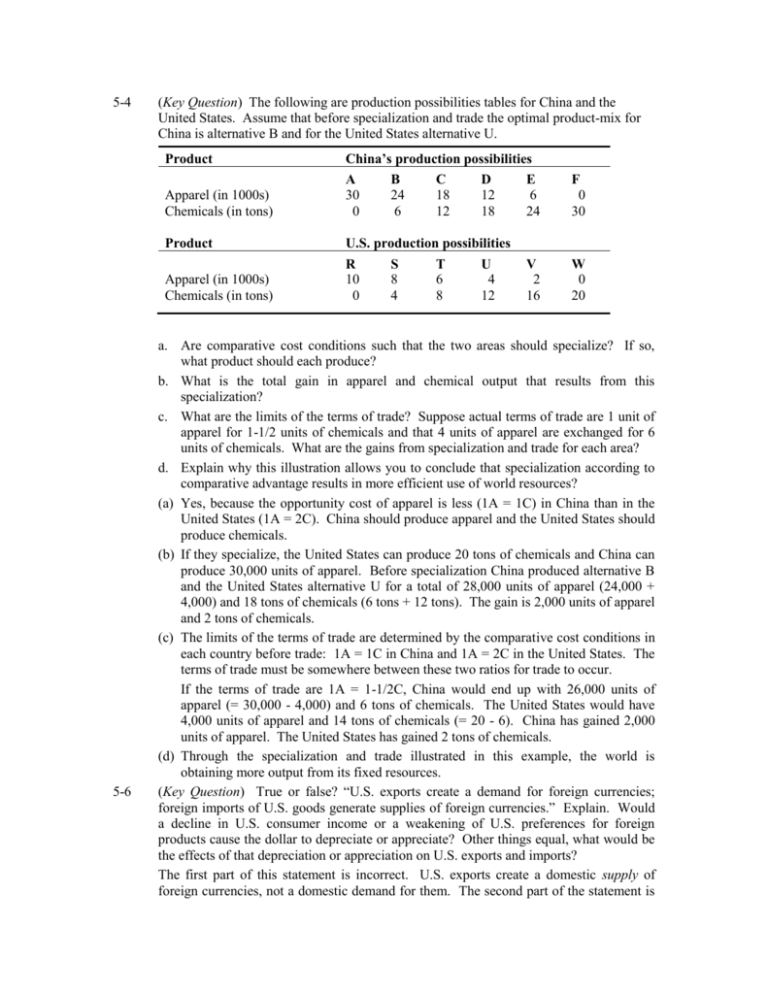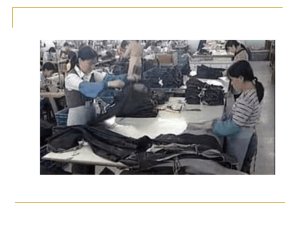Chapter 05 Key Question Solutions
advertisement

5-4 5-6 (Key Question) The following are production possibilities tables for China and the United States. Assume that before specialization and trade the optimal product-mix for China is alternative B and for the United States alternative U. Product China’s production possibilities Apparel (in 1000s) Chemicals (in tons) A 30 0 Product U.S. production possibilities Apparel (in 1000s) Chemicals (in tons) R 10 0 B 24 6 S 8 4 C 18 12 T 6 8 D 12 18 U 4 12 E 6 24 F 0 30 V 2 16 W 0 20 a. Are comparative cost conditions such that the two areas should specialize? If so, what product should each produce? b. What is the total gain in apparel and chemical output that results from this specialization? c. What are the limits of the terms of trade? Suppose actual terms of trade are 1 unit of apparel for 1-1/2 units of chemicals and that 4 units of apparel are exchanged for 6 units of chemicals. What are the gains from specialization and trade for each area? d. Explain why this illustration allows you to conclude that specialization according to comparative advantage results in more efficient use of world resources? (a) Yes, because the opportunity cost of apparel is less (1A = 1C) in China than in the United States (1A = 2C). China should produce apparel and the United States should produce chemicals. (b) If they specialize, the United States can produce 20 tons of chemicals and China can produce 30,000 units of apparel. Before specialization China produced alternative B and the United States alternative U for a total of 28,000 units of apparel (24,000 + 4,000) and 18 tons of chemicals (6 tons + 12 tons). The gain is 2,000 units of apparel and 2 tons of chemicals. (c) The limits of the terms of trade are determined by the comparative cost conditions in each country before trade: 1A = 1C in China and 1A = 2C in the United States. The terms of trade must be somewhere between these two ratios for trade to occur. If the terms of trade are 1A = 1-1/2C, China would end up with 26,000 units of apparel (= 30,000 - 4,000) and 6 tons of chemicals. The United States would have 4,000 units of apparel and 14 tons of chemicals (= 20 - 6). China has gained 2,000 units of apparel. The United States has gained 2 tons of chemicals. (d) Through the specialization and trade illustrated in this example, the world is obtaining more output from its fixed resources. (Key Question) True or false? “U.S. exports create a demand for foreign currencies; foreign imports of U.S. goods generate supplies of foreign currencies.” Explain. Would a decline in U.S. consumer income or a weakening of U.S. preferences for foreign products cause the dollar to depreciate or appreciate? Other things equal, what would be the effects of that depreciation or appreciation on U.S. exports and imports? The first part of this statement is incorrect. U.S. exports create a domestic supply of foreign currencies, not a domestic demand for them. The second part of the statement is 5-9 accurate. The foreign demand for dollars (from US. exports) generates a supply of foreign currencies to the United States. A decline in U.S. incomes or a weakening of U.S. preferences for foreign goods would reduce U.S. imports, reducing U.S. demand for foreign currencies. These currencies would depreciate (the dollar would appreciate). Dollar appreciation means U.S. exports would decline and U.S. imports would increase. (Key Question) Identify and state the significance of each of the following: (a) WTO; (b) EU; (c) euro; and (d) NAFTA. What commonality do they share? (a) The WTO oversees trade agreements reached by member nations and arbitrates trade disputes among them. (b) The EU is a trading bloc of 25 European countries who have agreed to abolish tariffs and import quotas on most products and have liberalized the movement of labor and capital within the EU. (c) The euro is the common currency that is used by 12 of the original 15 EU countries. (d) NAFTA is a trade bloc made up of the United Sates, Canada, and Mexico whose purpose is to reduce tariffs and other trade barriers among the three countries. All of the above have the goals of increasing international trade and leading to a better allocation of the world’s resources.








